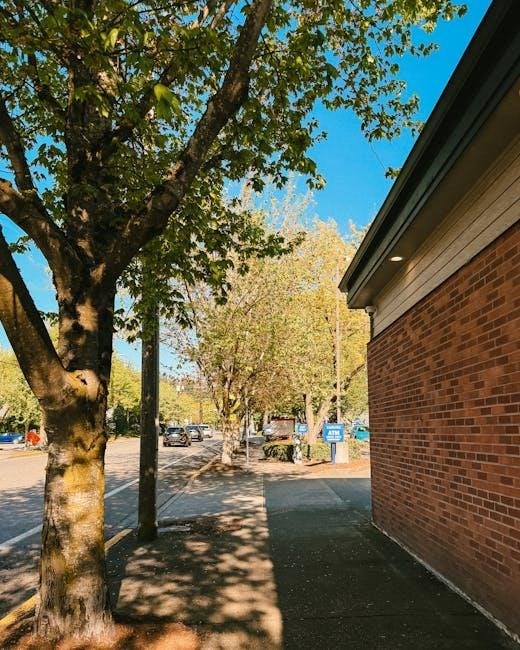
A Washington quit claim deed is a legal document transferring property ownership without guarantees, often used for family transfers or divorce settlements, offering no title warranties.
1.1 Definition and Purpose
A quit claim deed in Washington State is a legal document that transfers property ownership from one party to another without guaranteeing the title’s quality or the grantor’s ownership rights. Its primary purpose is to convey whatever interest the grantor has in the property, making it useful for straightforward transfers, such as between family members or during divorce settlements, without providing title warranties.
1.2 Legal Implications
A quit claim deed in Washington State transfers property without guaranteeing title quality, meaning the grantor doesn’t ensure the title is clear of liens or disputes. While it effectively conveys ownership, the grantee assumes all risks, including potential claims or defects. It’s a legally binding document but offers no warranties, making it riskier for buyers compared to warranty deeds.
Key Elements of a Quit Claim Deed Form
A quit claim deed form includes the grantor and grantee names, property description, signatures, notarization, tax information, and consideration details to legally transfer ownership rights.
2.1 Names and Addresses of Grantor and Grantee
The quit claim deed requires the full legal names and current addresses of both the grantor (owner transferring the property) and the grantee (recipient of the property). This section ensures clarity in identifying the parties involved in the transaction and is legally required for proper documentation and verification purposes.
2.2 Legal Description of the Property
The legal description of the property must be included, detailing its location and boundaries. This typically includes the street address, tax account number, and a precise description of the land. The information ensures the property is accurately identified, avoiding future disputes or confusion about the transferred assets.
2.3 Signatures and Notarization
The grantor must sign the deed in the presence of a notary public, who verifies their identity and authenticates the signature. This step ensures the document’s legality and validity. The grantee’s signature is optional but recommended for acknowledgment. Proper notarization is essential to confirm the grantor’s voluntary transfer of property rights, ensuring the deed is enforceable under Washington state law.
2.4 Tax Information and Consideration
The quit claim deed must include tax information, such as tax account numbers, to ensure proper assessment. The consideration section details the payment or exchange, which may be monetary or non-monetary. In Washington State, tax implications vary; transfers between family members may qualify for exemptions, while others may incur transfer taxes. Accurate documentation is crucial for tax purposes and legal compliance.

How to Fill Out the Quit Claim Deed Form
Gather all necessary information about the property and parties. Fill in the grantor and grantee names, property description, tax details, and consideration. Include signatures and notarization, ensuring accuracy.
3.1 Gathering Necessary Information
Gathering necessary information is the first step in preparing a quit claim deed. Collect details about the property, including its legal description, tax account numbers, and location. Identify the full names and addresses of both the grantor and grantee. Ensure all information is accurate to avoid errors in the deed. Verify the property’s history and any existing liens or encumbrances. Consult professionals if unsure.
3.2 Filling in the Form Step-by-Step
Begin by filling in the grantor’s and grantee’s full names and addresses. Next, provide the legal description of the property, including tax account numbers. Specify the consideration, if any, and the grantor’s signature. Ensure the document is notarized, and include witness signatures if required. Attach any additional documentation, such as affidavits or property tax statements, to complete the form accurately.
3.3 Reviewing and Correcting Errors
Thoroughly review the completed quit claim deed for accuracy. Verify names, addresses, and property descriptions. Ensure all signatures are present and correctly notarized. Check for typos or omissions in legal descriptions or tax information. Correct any errors before filing, as mistakes can lead to legal disputes. Consider consulting a legal professional to ensure the document is valid and enforceable in Washington State.

Filing the Quit Claim Deed
File the completed quit claim deed with the County Auditor’s office in the county where the property is located. Recording fees apply to finalize the process.
4.1 Where to File the Deed
In Washington State, the quit claim deed must be filed with the County Auditor’s office in the county where the property is located. For example, if the property is in King County, submit the deed to the King County Auditor. Ensure the document is properly notarized and includes all required signatures before recording. This step officially records the transfer of ownership.
4.2 Fees and Recording Requirements
Filing a quit claim deed in Washington State typically requires a recording fee, which is approximately $70-$100. This fee covers the processing and recording of the deed. Additional charges may apply for multiple pages or special requests. Ensure the deed is properly notarized and includes a cover sheet, as required by the County Auditor’s office. These fees are essential for securing your property transfer legally.

Differences Between Quit Claim and Other Deeds
A quit claim deed differs from warranty deeds as it offers no title guarantees, transferring only the grantor’s existing interest, unlike warranty deeds, which provide title assurances.
5.1 Comparison with Warranty Deed
A quit claim deed differs significantly from a warranty deed, as it does not guarantee the grantor’s ownership or title quality, unlike warranty deeds, which provide assurances. Warranty deeds ensure the grantor has clear title and protects against claims, making them common in real estate purchases. In contrast, quit claim deeds are often used for non-market transfers, such as between family members or in divorce settlements.
5.2 Special Considerations in Washington State
In Washington State, quit claim deeds are recognized for transferring property ownership without title guarantees, often used in family transfers or divorce settlements. They lack warranty of title, making them unsuitable for traditional real estate purchases. The state requires proper documentation, including tax account numbers and county-specific filing procedures. This method is popular for its simplicity but carries risks due to the absence of title assurances.
Legal Implications and Risks
A quit claim deed in Washington State offers no title warranty, posing risks like potential disputes and liabilities due to unclear ownership claims or hidden issues.
6.1 No Warranty of Title
A quit claim deed in Washington State does not guarantee the grantor’s ownership or the title’s quality, meaning the grantee assumes all risks of defects or disputes.
6.2 Potential Disputes and Liabilities
A quit claim deed in Washington State may lead to disputes, as it offers no warranty of title. The grantee could face hidden liens, unpaid taxes, or claims from third parties. If the grantor lacked rightful ownership, the deed provides no legal protection, potentially leading to financial loss or legal battles for the grantee.
Common Uses of Quit Claim Deed
A quit claim deed is often used to transfer property to family members or settle divorce-related property disputes, providing a straightforward method without title warranties.
7.1 Transferring Property to Family Members
A quit claim deed is commonly used to transfer property to family members, such as from parents to children, as it provides a simple and efficient way to convey ownership without guarantees. This method is particularly popular for intra-family transfers, allowing individuals to pass property rights swiftly and avoid complex legal processes. However, it offers no title warranties, meaning the grantee assumes any existing risks or liens.
7.2 Divorce and Property Settlements
A quit claim deed is often used in divorce proceedings to transfer property ownership between spouses as part of a settlement. It allows one party to relinquish their interest in the property without guaranteeing the title’s validity. This method is efficient for dividing assets but does not protect against future claims or liens, making it a common choice in property distribution during divorce.
Tax Implications
A quit claim deed may trigger property tax reassessments and transfer taxes. Exemptions apply in certain cases, such as transfers between spouses or family members in Washington State.
8.1 Property Taxes and Assessments
A quit claim deed may trigger a property tax reassessment, potentially increasing the taxable value of the property. The tax basis is typically the property’s assessed value at the time of transfer. In Washington State, exemptions may apply for certain transfers, such as between family members or spouses, reducing tax liabilities. Understanding these implications is crucial for tax planning.
8;2 Transfer Taxes and Exemptions
In Washington State, real estate transfer taxes apply to property transfers, including those via quit claim deeds. The state does not impose a transfer tax, but local counties may charge fees. Exemptions exist for certain transfers, such as between spouses, parents, or children. The tax rate varies by county, and documentation may be required to claim exemptions. Proper filing ensures compliance and potential tax savings.

Free Resources for Quit Claim Deed Forms
Free quit claim deed forms for Washington State are available on official county websites and legal document providers, offering downloadable PDF templates for property transfers, including county recording offices and legal platforms.
9.1 Official Washington State Websites
Official Washington State websites, such as county recorder’s offices and legal document platforms, provide free downloadable quit claim deed forms in PDF format. These resources include templates like LPB 12-05 (rev. 07.2021), designed for property transfers. Users can access these forms directly from government or trusted legal websites, ensuring accuracy and compliance with state regulations for seamless recording and processing.
9.2 Legal Document Providers
Legal document providers offer downloadable quit claim deed forms specific to Washington State in PDF format. Websites like legal document services provide customizable templates, such as LPB 12-05 (rev. 07.2021), ensuring compliance with state laws. These platforms often include pre-drafted language and step-by-step instructions, making it easier for individuals to prepare and execute the deed accurately without legal assistance.
Avoiding Common Mistakes
Ensure accuracy in property descriptions and proper notarization of signatures to prevent legal disputes and ensure validity.
10.1 Errors in Property Description
Accurate property descriptions are crucial. Errors in tax account numbers, boundaries, or legal details can lead to disputes. Ensure the description matches public records to avoid invalidation of the deed.
10.2 Incorrect Signatures or Notarization
Incorrect signatures or notarization can invalidate the deed. Ensure the grantor signs in the presence of a notary, who verifies their identity. Missing or forged signatures can lead to legal disputes. Proper notarization confirms the grantor’s consent, making the deed legally binding. All parties must sign correctly to avoid challenges to the deed’s validity.
A Washington quit claim deed is a straightforward yet legally significant document for transferring property ownership. While it offers no title guarantees, its simplicity makes it ideal for family transfers or divorce settlements. Proper execution is crucial to avoid disputes. Always consult a legal professional to ensure accuracy and compliance with state requirements.
Leave a Reply
You must be logged in to post a comment.